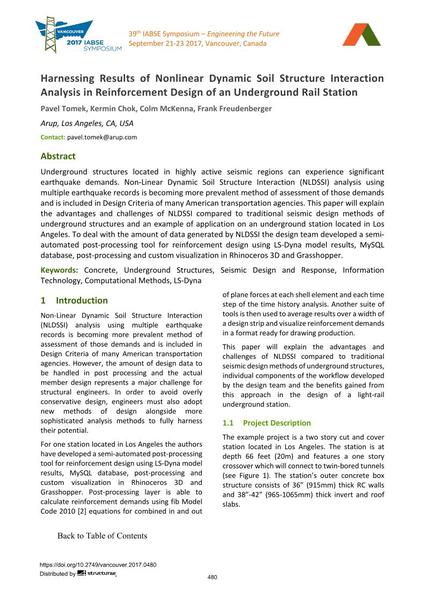Harnessing Results of Nonlinear Dynamic Soil Structure Interaction Analysis in Reinforcement Design of an Underground Rail Station

|
|
|||||||||||
Détails bibliographiques
| Auteur(s): |
Pavel Tomek
(Arup, Los Angeles, CA, USA)
Kermin Chok (Arup, Los Angeles, CA, USA) Colm McKenna (Arup, Los Angeles, CA, USA) Frank Freudenberger (Arup, Los Angeles, CA, USA) |
||||
|---|---|---|---|---|---|
| Médium: | papier de conférence | ||||
| Langue(s): | anglais | ||||
| Conférence: | IABSE Symposium: Engineering the Future, Vancouver, Canada, 21-23 September 2017 | ||||
| Publié dans: | IABSE Symposium Vancouver 2017 | ||||
|
|||||
| Page(s): | 480-486 | ||||
| Nombre total de pages (du PDF): | 7 | ||||
| Année: | 2017 | ||||
| DOI: | 10.2749/vancouver.2017.0480 | ||||
| Abstrait: |
Underground structures located in highly active seismic regions can experience significant earthquake demands. Non-Linear Dynamic Soil Structure Interaction (NLDSSI) analysis using multiple earthquake records is becoming more prevalent method of assessment of those demands and is included in Design Criteria of many American transportation agencies. This paper will explain the advantages and challenges of NLDSSI compared to traditional seismic design methods of underground structures and an example of application on an underground station located in Los Angeles. To deal with the amount of data generated by NLDSSI the design team developed a semi- automated post-processing tool for reinforcement design using LS-Dyna model results, MySQL database, post-processing and custom visualization in Rhinoceros 3D and Grasshopper. |
||||
| Mots-clé: |
béton Ouvrage souterrain
|
||||

